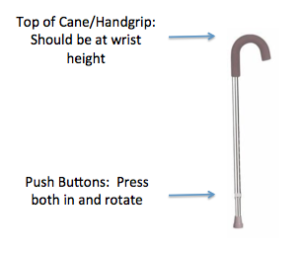Fitting
Cane Height: Adjust the cane height by pressing both buttons and rotating the bottom piece. Ideally, the top of the cane should be to the patient's wrist with the bottom of the cane right next to their foot. As a person holds onto the cane handgrip there should be a slight bend in the patient's arm. Once measured, rotate the bottom piece to lock the buttons in place.

Buy on Amazon
Video
Safety
Before using the cane it is important to make sure:
- The cane is correctly fitted
- All buttons are are engaged fully and are not pressed in
- The tip of the cane is not completely worn at the bottom
- The handgrip is attached sturdily and does not move when pressure is applied through it
- No components are loose
- Inspect the cane and parts for dents, cracks, or any irregularities
Stairs
When performing stairs, the cane should always stay with and move with the injured lower extremity.
Ascending: When ascending the stairs the patient should always start by placing the non-injured lower extremity on the stair. The patient will then press through the non-injured lower extremity and move the injured lower extremity simultaneously with the cane to the same stair. (Think "Good Goes Up First") This pattern is repeated until the stairs are completed.
Descending: When descending the stairs the patient should always start by moving the cane and injured lower extremity to the lower stair. This makes the non-injured lower extremity do all the work and control the patient's weight. (Think "Bad Goes Down First") This pattern is repeated until the stairs are completed.
It is important to remember not to allow the bottom of the cane to be near the edge of the stair when ascending and descending for safety concerns.
References
Durable Medical Equipment. (2018). 1st ed. [ebook] Port Washington, N.Y.: Medical Depot, p.21. Available at: https://www.medline.com/media/catalog/Docs/MKT/LIT124R_CAT_Bath%20Safety%20and%20Walking%20.pdf [Accessed 16 Mar. 2018].
